Mangrove Forest Cover Change in the Conterminous United States from 1980–2020
Abstract
:1. Introduction
2. Study Area, Data Basis, and Methods
2.1. Study Area
2.2. Data and Methods
3. Results and Discussion
3.1. Mangrove Distribution
3.2. Mangrove Change
3.3. Proximate Causes of Mangrove Change
3.4. Results Validation
4. Limitations
5. Conclusions
Author Contributions
Funding
Data Availability Statement
Acknowledgments
Conflicts of Interest
References
- Giri, C.; Ochieng, E.; Tieszen, L.L.; Zhu, Z.; Singh, A.; Loveland, T.; Masek, J.; Duke, N. Status and Distribution of Mangrove Forests of the World Using Earth Observation Satellite Data. Glob. Ecol. Biogeogr. 2011, 20, 154–159. [Google Scholar] [CrossRef]
- Zhang, K.; Thapa, B.; Ross, M.; Gann, D. Remote Sensing of Seasonal Changes and Disturbances in Mangrove Forest: A Case Study from South Florida. Ecosphere 2016, 7, e01366. [Google Scholar] [CrossRef]
- Giri, C. Frontiers in Global Mangrove Forest Monitoring. Remote Sens. 2023, 15, 3852. [Google Scholar] [CrossRef]
- Vo, Q.T.; Künzer, C.; Vo, Q.M.; Moder, F.; Oppelt, N. Review of Valuation Methods for Mangrove Ecosystem Services. Ecol. Indic. 2012, 23, 431–446. [Google Scholar] [CrossRef]
- Afonso, F.; Félix, P.M.; Chainho, P.; Heumüller, J.A.; de Lima, R.F.; Ribeiro, F.; Brito, A.C. Community Perceptions about Mangrove Ecosystem Services and Threats. Reg. Stud. Mar. Sci. 2022, 49, 102114. [Google Scholar] [CrossRef]
- Bardou, R.; Osland, M.J.; Scyphers, S.; Shepard, C.; Aerni, K.E.; Alemu, I.J.B.; Crimian, R.; Day, R.H.; Enwright, N.M.; Feher, L.C. Rapidly Changing Range Limits in a Warming World: Critical Data Limitations and Knowledge Gaps for Advancing Understanding of Mangrove Range Dynamics in the Southeastern USA. Estuaries Coasts 2023, 46, 1123–1140. [Google Scholar] [CrossRef]
- Parkinson, R.W.; Wdowinski, S. Accelerating Sea-Level Rise and the Fate of Mangrove Plant Communities in South Florida, USA. Geomorphology 2022, 412, 108329. [Google Scholar] [CrossRef]
- Osland, M.J.; Hughes, A.R.; Armitage, A.R.; Scyphers, S.B.; Cebrian, J.; Swinea, S.H.; Shepard, C.C.; Allen, M.S.; Feher, L.C.; Nelson, J.A. The Impacts of Mangrove Range Expansion on Wetland Ecosystem Services in the Southeastern United States: Current Understanding, Knowledge Gaps, and Emerging Research Needs. Glob. Chang. Biol. 2022, 28, 3163–3187. [Google Scholar] [CrossRef]
- Gilman, E.L.; Ellison, J.; Duke, N.C.; Field, C. Threats to Mangroves from Climate Change and Adaptation Options: A Review. Aquat. Bot. 2008, 89, 237–250. [Google Scholar] [CrossRef]
- Romañach, S.S.; DeAngelis, D.L.; Koh, H.L.; Li, Y.; Teh, S.Y.; Barizan, R.S.R.; Zhai, L. Conservation and Restoration of Mangroves: Global Status, Perspectives, and Prognosis. Ocean Coast. Manag. 2018, 154, 72–82. [Google Scholar] [CrossRef]
- Duke, N.C.; Meynecke, J.-O.; Dittmann, S.; Ellison, A.M.; Anger, K.; Berger, U.; Cannicci, S.; Diele, K.; Ewel, K.C.; Field, C.D. A World without Mangroves? Science 2007, 317, 41–42. [Google Scholar] [CrossRef] [PubMed]
- Cavanaugh, K.C.; Kellner, J.R.; Forde, A.J.; Gruner, D.S.; Parker, J.D.; Rodriguez, W.; Feller, I.C. Poleward Expansion of Mangroves Is a Threshold Response to Decreased Frequency of Extreme Cold Events. Proc. Natl. Acad. Sci. USA 2014, 111, 723–727. [Google Scholar] [CrossRef]
- Alongi, D.M. The Impact of Climate Change on Mangrove Forests. Curr. Clim. Chang. Rep. 2015, 1, 30–39. [Google Scholar] [CrossRef]
- Godoy, M.D.; Lacerda, L.D.D. Mangroves Response to Climate Change: A Review of Recent Findings on Mangrove Extension and Distribution. An. Acad. Bras. Ciênc. 2015, 87, 651–667. [Google Scholar] [CrossRef] [PubMed]
- Giri, C.; Long, J. Is the Geographic Range of Mangrove Forests in the Conterminous United States Really Expanding? Sensors 2016, 16, 2010. [Google Scholar] [CrossRef] [PubMed]
- Smith, T.J.; Foster, A.M.; Tiling-Range, G.; Jones, J.W. Dynamics of Mangrove-Marsh Ecotones in Subtropical Coastal Wetlands: Fire, Sea-Level Rise, and Water Levels. Fire Ecol. 2013, 9, 66–77. [Google Scholar] [CrossRef]
- Ansley, R.J.; Rivera-Monroy, V.H.; Griffis-Kyle, K.; Hoagland, B.; Emert, A.; Fagin, T.; Loss, S.R.; McCarthy, H.R.; Smith, N.G.; Waring, E.F. Assessing Impacts of Climate Change on Selected Foundation Species and Ecosystem Services in the South-Central USA. Ecosphere 2023, 14, e4412. [Google Scholar] [CrossRef]
- Chander, G.; Markham, B.L.; Helder, D.L. Summary of Current Radiometric Calibration Coefficients for Landsat MSS, TM, ETM+, and EO-1 ALI Sensors. Remote Sens. Environ. 2009, 113, 893–903. [Google Scholar] [CrossRef]
- Wulder, M.A.; White, J.C.; Loveland, T.R.; Woodcock, C.E.; Belward, A.S.; Cohen, W.B.; Fosnight, E.A.; Shaw, J.; Masek, J.G.; Roy, D.P. The Global Landsat Archive: Status, Consolidation, and Direction. Remote Sens. Environ. 2016, 185, 271–283. [Google Scholar] [CrossRef]
- Roy, D.P.; Ju, J.; Kline, K.; Scaramuzza, P.L.; Kovalskyy, V.; Hansen, M.; Loveland, T.R.; Vermote, E.; Zhang, C. Web-Enabled Landsat Data (WELD): Landsat ETM+ Composited Mosaics of the Conterminous United States. Remote Sens. Environ. 2010, 114, 35–49. [Google Scholar] [CrossRef]
- Qiu, S.; Zhu, Z.; Olofsson, P.; Woodcock, C.E.; Jin, S. Evaluation of Landsat Image Compositing Algorithms. Remote Sens. Environ. 2023, 285, 113375. [Google Scholar] [CrossRef]
- Tamiminia, H.; Salehi, B.; Mahdianpari, M.; Quackenbush, L.; Adeli, S.; Brisco, B. Google Earth Engine for Geo-Big Data Applications: A Meta-Analysis and Systematic Review. ISPRS J. Photogramm. Remote Sens. 2020, 164, 152–170. [Google Scholar] [CrossRef]
- Phan, T.N.; Kuch, V.; Lehnert, L.W. Land Cover Classification Using Google Earth Engine and Random Forest Classifier—The Role of Image Composition. Remote Sens. 2020, 12, 2411. [Google Scholar] [CrossRef]
- Belgiu, M.; Drăguţ, L. Random Forest in Remote Sensing: A Review of Applications and Future Directions. ISPRS J. Photogramm. Remote Sens. 2016, 114, 24–31. [Google Scholar] [CrossRef]
- Elmahdy, S.I.; Ali, T.A.; Mohamed, M.M.; Howari, F.M.; Abouleish, M.; Simonet, D. Spatiotemporal Mapping and Monitoring of Mangrove Forests Changes From 1990 to 2019 in the Northern Emirates, UAE Using Random Forest, Kernel Logistic Regression and Naive Bayes Tree Models. Front. Environ. Sci. 2020, 8, 102. [Google Scholar] [CrossRef]
- Ghorbanian, A.; Zaghian, S.; Asiyabi, R.M.; Amani, M.; Mohammadzadeh, A.; Jamali, S. Mangrove Ecosystem Mapping Using Sentinel-1 and Sentinel-2 Satellite Images and Random Forest Algorithm in Google Earth Engine. Remote Sens. 2021, 13, 2565. [Google Scholar] [CrossRef]
- Lagomasino, D.; Fatoyinbo, T.; Castañeda-Moya, E.; Cook, B.D.; Montesano, P.M.; Neigh, C.S.; Corp, L.A.; Ott, L.E.; Chavez, S.; Morton, D.C. Storm Surge and Ponding Explain Mangrove Dieback in Southwest Florida Following Hurricane Irma. Nat. Commun. 2021, 12, 4003. [Google Scholar] [CrossRef]
- Xiong, L.; Lagomasino, D.; Charles, S.P.; Castañeda-Moya, E.; Cook, B.D.; Redwine, J.; Fatoyinbo, L. Quantifying Mangrove Canopy Regrowth and Recovery after Hurricane Irma with Large-Scale Repeat Airborne Lidar in the Florida Everglades. Int. J. Appl. Earth Obs. Geoinf. 2022, 114, 103031. [Google Scholar] [CrossRef]
- Lagomasino, D.; Fatoyinbo, L.; Castaneda, E.; Cook, B.; Montesano, P.; Neigh, C.; Ott, L.; Chavez, S.; Morton, D. Storm Surge, Not Wind, Caused Mangrove Dieback in Southwest Florida Following Hurricane Irma. Earth ArXiv 2020. preprint. [Google Scholar]
- Coldren, G.A.; Langley, J.A.; Feller, I.C.; Chapman, S.K. Warming Accelerates Mangrove Expansion and Surface Elevation Gain in a Subtropical Wetland. J. Ecol. 2019, 107, 79–90. [Google Scholar] [CrossRef]
- Cohen, M.C.L.; De Souza, A.V.; Liu, K.; Rodrigues, E.; Yao, Q.; Ryu, J.; Dietz, M.; Pessenda, L.C.R.; Rossetti, D. Effects of the 2017–2018 Winter Freeze on the Northern Limit of the American Mangroves, Mississippi River Delta Plain. Geomorphology 2021, 394, 107968. [Google Scholar] [CrossRef]
- Krauss, K.W.; From, A.S.; Doyle, T.W.; Doyle, T.J.; Barry, M.J. Sea-Level Rise and Landscape Change Influence Mangrove Encroachment onto Marsh in the Ten Thousand Islands Region of Florida, USA. J. Coast. Conserv. 2011, 15, 629–638. [Google Scholar] [CrossRef]
- Stehman, S.V.; Olofsson, P.; Woodcock, C.E.; Herold, M.; Friedl, M.A. A Global Land-Cover Validation Data Set, II: Augmenting a Stratified Sampling Design to Estimate Accuracy by Region and Land-Cover Class. Int. J. Remote Sens. 2012, 33, 6975–6993. [Google Scholar] [CrossRef]
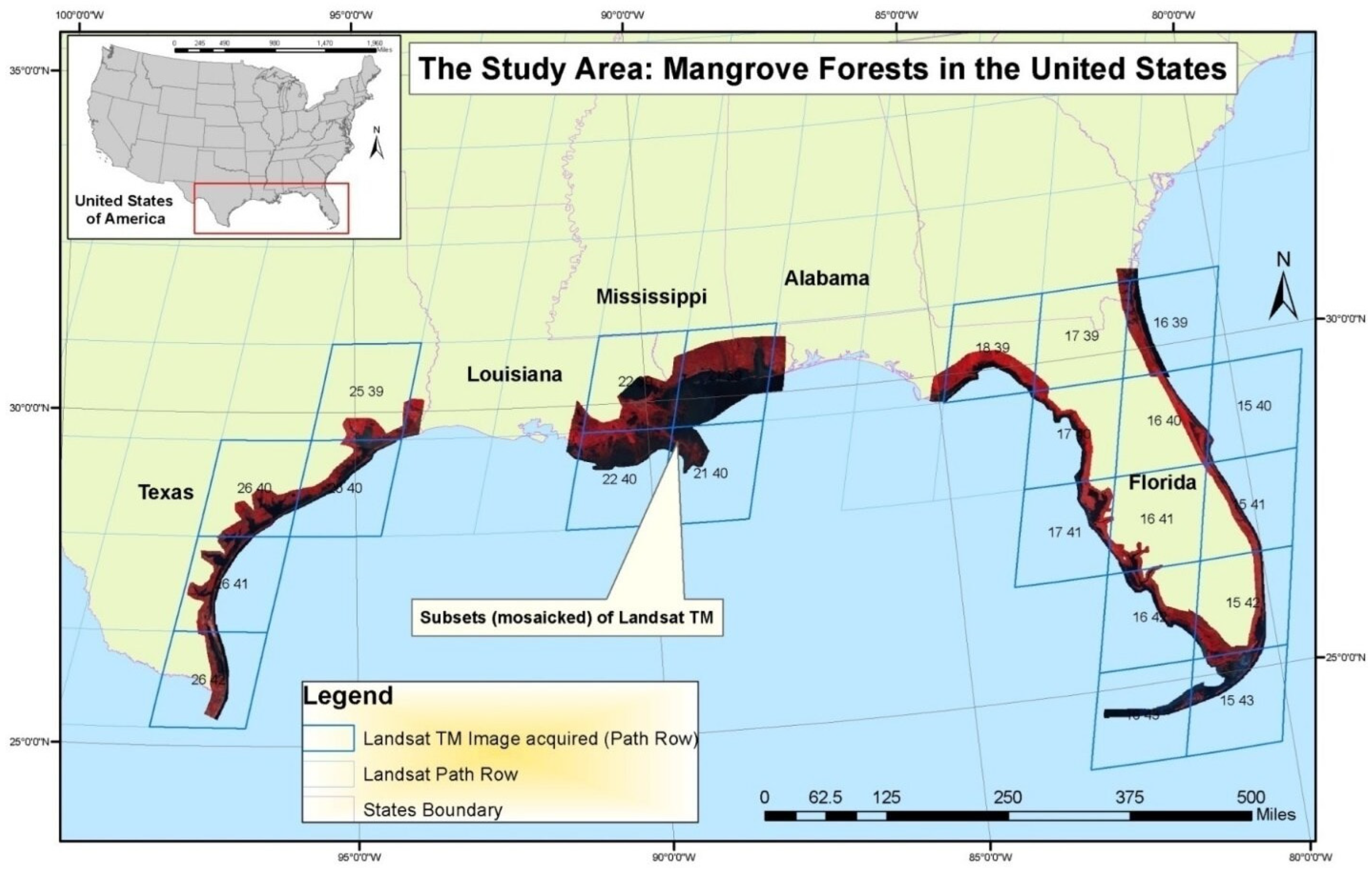

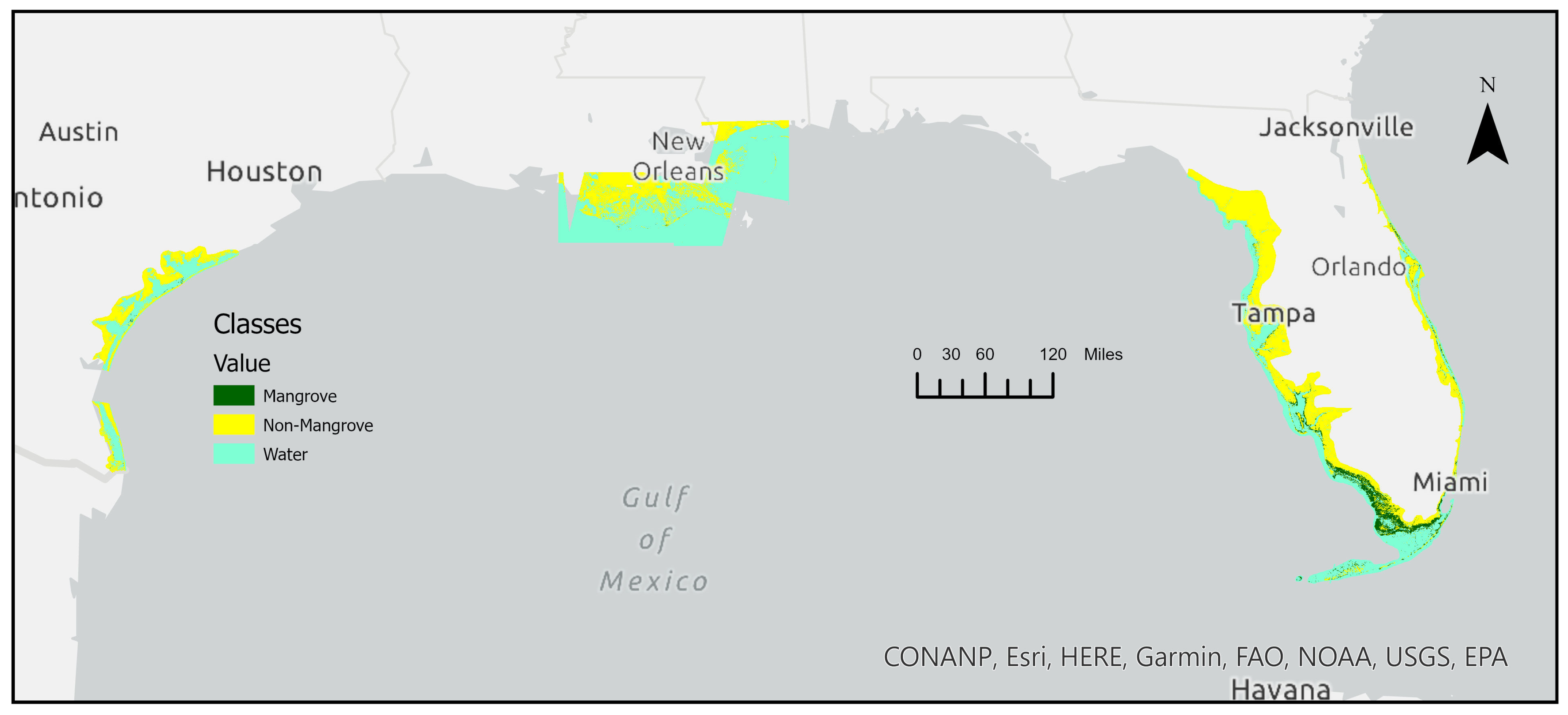

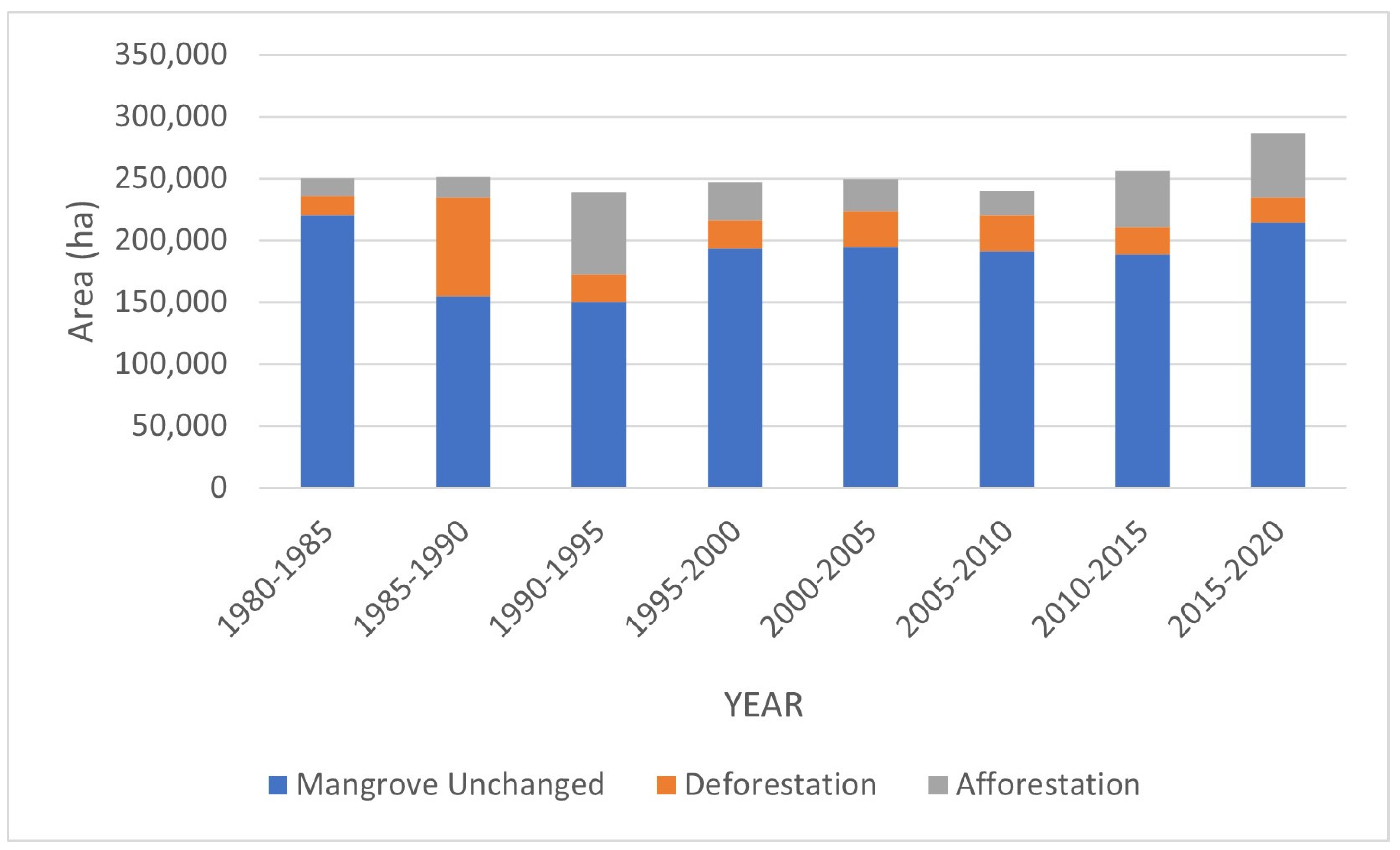

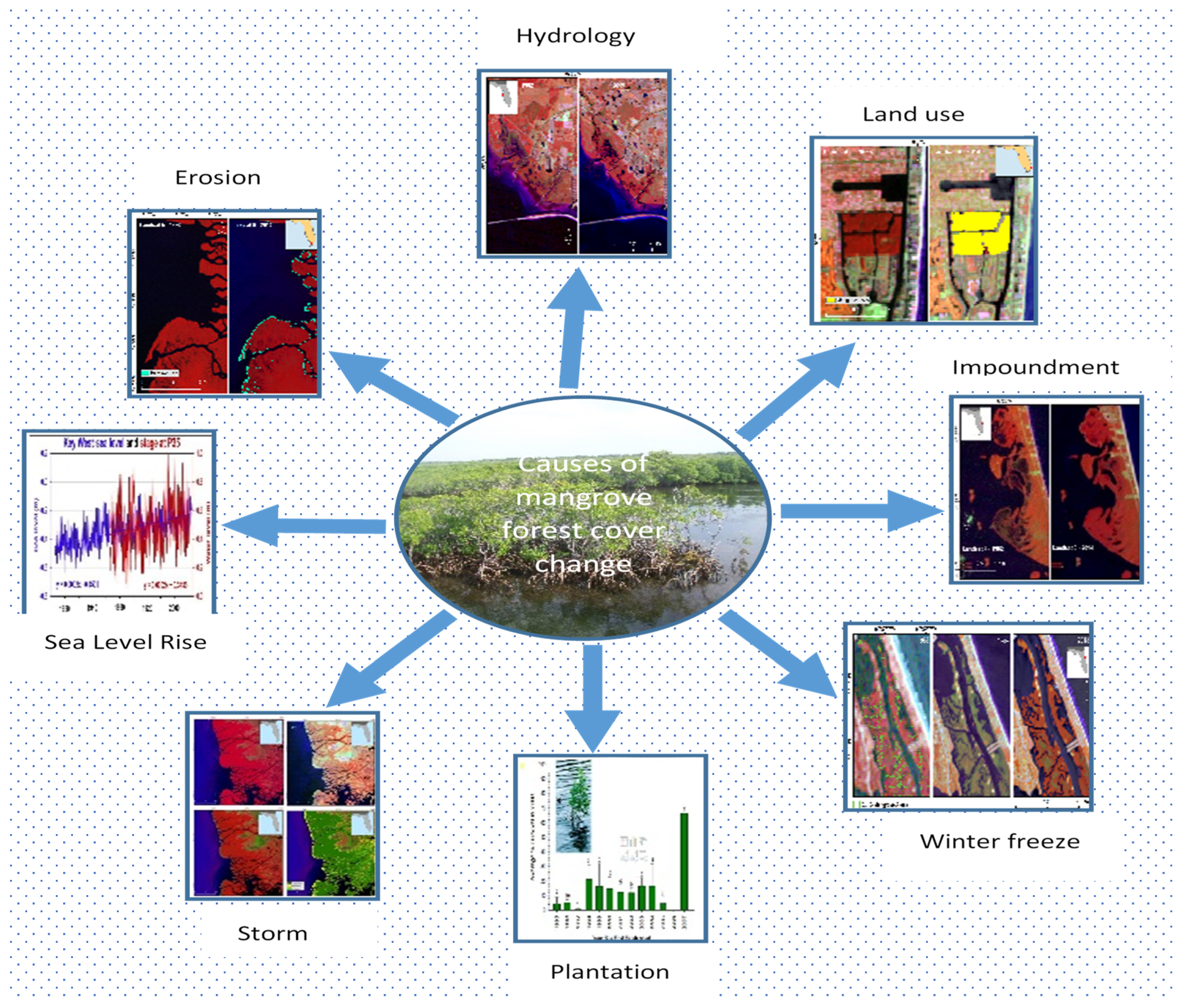
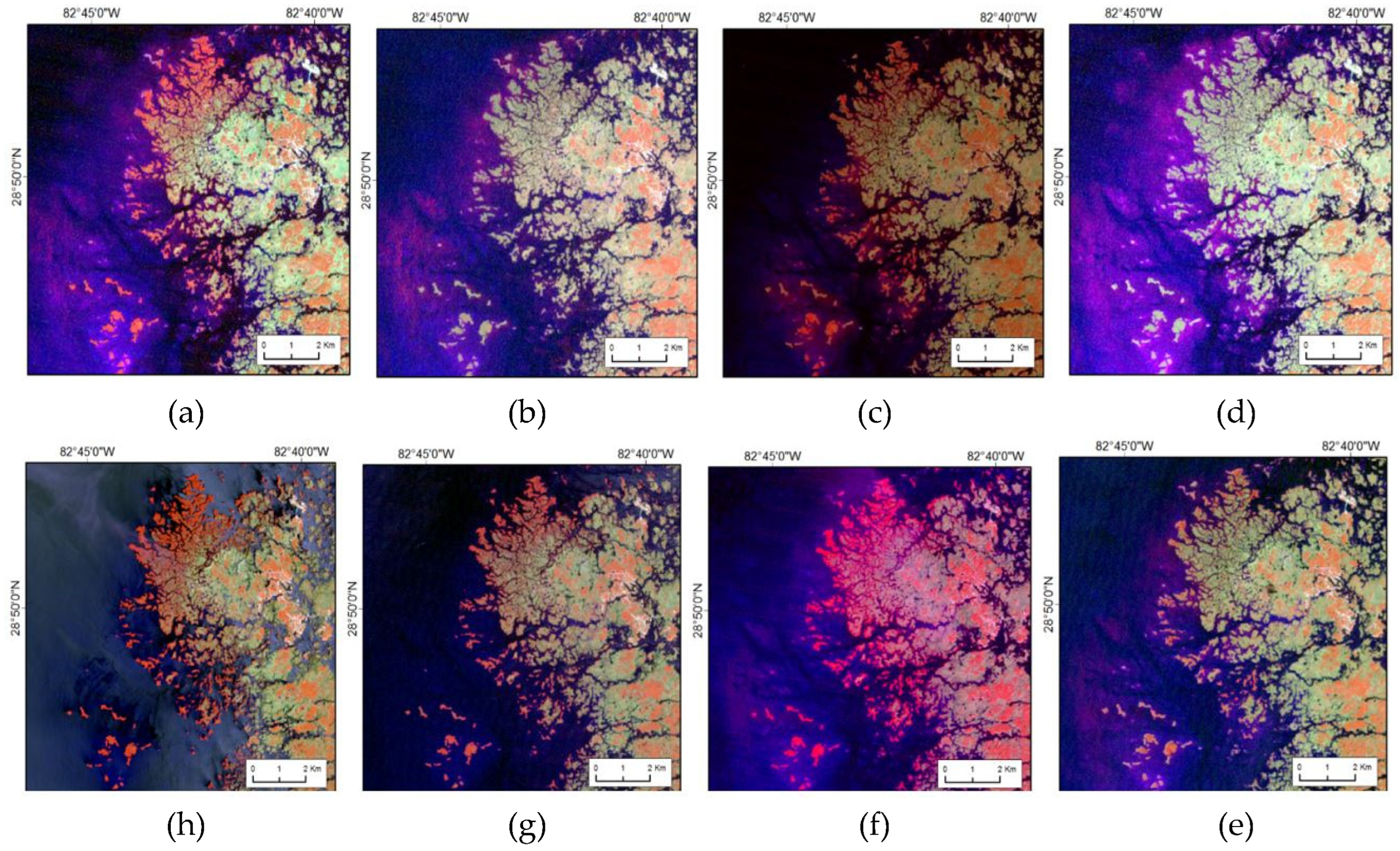
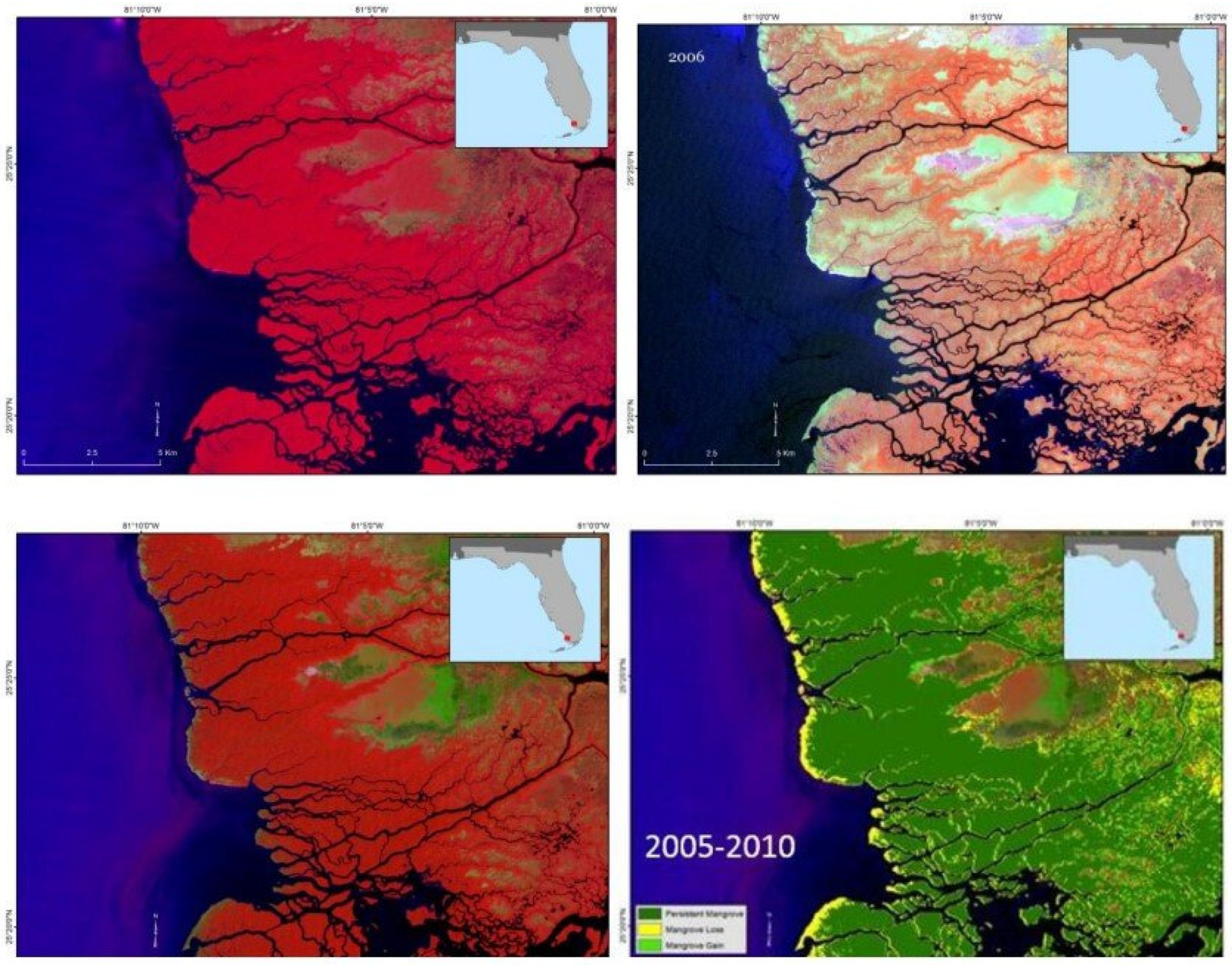
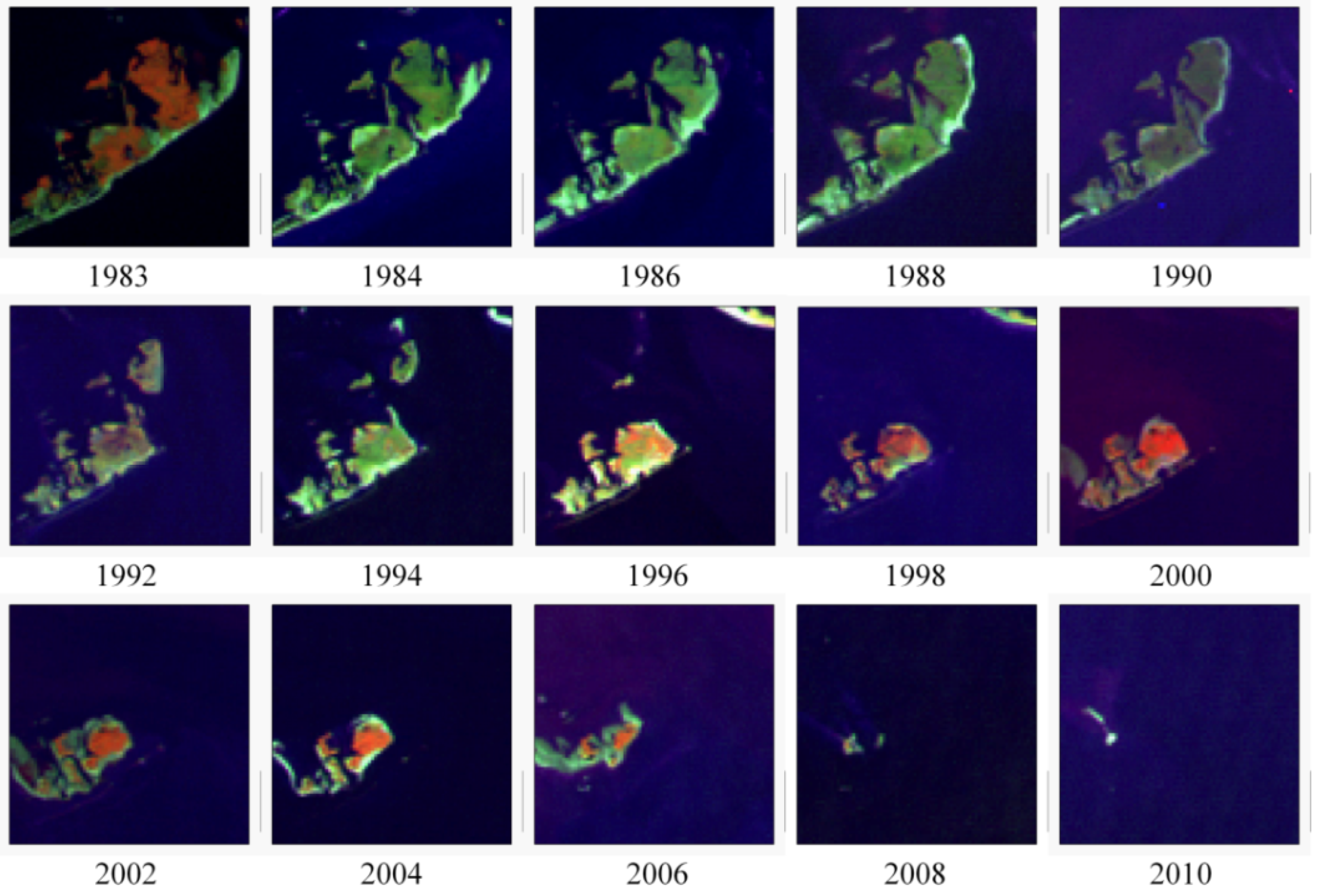
| Land Cover Types | Description |
|---|---|
| Mangrove | True mangroves that grow in brackish and saline water. In the United States, three main species are found: red, black, and white mangroves |
| Non-mangrove | All land use/land cover classes other than mangrove and water bodies including cropland, urban areas, barren land, shrubland, and grassland |
| Water bodies | Ocean water, brackish water, perennial river, streams and water reservoirs, and open water like lakes and ponds. |
| State | Latitude (in Decimal Degrees) | Longitude (in Decimal Degrees) | ||
|---|---|---|---|---|
| 1980 | 2020 | 1980 | 2020 | |
| Eastern Florida | 29.86373 | 29.94541 | −81.30328 | −81.31730 |
| Western Florida | 29.16205 | 29.16232 | −83.04640 | −83.046480 |
| Louisiana | 30.03801 | 29.97985 | −88.86036 | −88.83519 |
| Texas | 28.42891 | 28.43685 | −96.41026 | −96.40120 |
| Classified Data | Reference Data | Producers Accuracy | Users Accuracy | ||
|---|---|---|---|---|---|
| Mangrove | Non-mangrove | Water | |||
| Mangrove | 23 | 1 | 1 | 100.00 | 92.00 |
| Non-mangrove | 0 | 35 | 1 | 92.11 | 97.22 |
| Water | 1 | 2 | 37 | 95.87 | 94.87 |
| Overall Accuracy = 95% | |||||
Disclaimer/Publisher’s Note: The statements, opinions and data contained in all publications are solely those of the individual author(s) and contributor(s) and not of MDPI and/or the editor(s). MDPI and/or the editor(s) disclaim responsibility for any injury to people or property resulting from any ideas, methods, instructions or products referred to in the content. |
© 2023 by the authors. Licensee MDPI, Basel, Switzerland. This article is an open access article distributed under the terms and conditions of the Creative Commons Attribution (CC BY) license (https://creativecommons.org/licenses/by/4.0/).
Share and Cite
Giri, C.; Long, J.; Poudel, P. Mangrove Forest Cover Change in the Conterminous United States from 1980–2020. Remote Sens. 2023, 15, 5018. https://doi.org/10.3390/rs15205018
Giri C, Long J, Poudel P. Mangrove Forest Cover Change in the Conterminous United States from 1980–2020. Remote Sensing. 2023; 15(20):5018. https://doi.org/10.3390/rs15205018
Chicago/Turabian StyleGiri, Chandra, Jordan Long, and Prapti Poudel. 2023. "Mangrove Forest Cover Change in the Conterminous United States from 1980–2020" Remote Sensing 15, no. 20: 5018. https://doi.org/10.3390/rs15205018
APA StyleGiri, C., Long, J., & Poudel, P. (2023). Mangrove Forest Cover Change in the Conterminous United States from 1980–2020. Remote Sensing, 15(20), 5018. https://doi.org/10.3390/rs15205018







